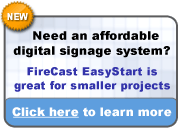It still strikes me as funny (or maybe ironic) that TV networks are using in-store digital signage networks to entice viewers of the latter to watch more of the former, but I realize there's a legitimate business model behind that decision.
And just how legitimate is it, you might ask? Well Danoo, one of the larger "hyperlocal" networks in the US today, would tell you the following, if today's press release is anything to go on:
Today, though, all the viewer really has to remember is the name of the show being advertised. Then, with a quick trip to the web he or she could pull up the network's website and start streaming the episode (for most major network shows, anyway). That removes a lot of detail from the recall process -- there's just one thing to recall instead of three -- and it also removes the timeliness since viewers can stream network TV over the Internet at any time of day and any day of the week.
Tags: digital signage, advertising, danoo
And just how legitimate is it, you might ask? Well Danoo, one of the larger "hyperlocal" networks in the US today, would tell you the following, if today's press release is anything to go on:
I don't really know anything about advertising network TV shows, but I'd have to imagine that now's a better time to do it than any time in the past two decades. One of the big benefits of digital out-of-home advertising is that you can include a call to action and encourage viewers to complete a specific act. For advertising-funded networks this might typically be in the form of a "buy now" type message, since the advertisements are usually for products sold in store. However, TV networks have always had a bigger challenge: they need to communicate the benefits of the program being advertised, encourage the viewer to watch the program, and then hope that the viewer makes it out of the store, all the way back home, and then remembers to turn on the right channel at the right time.The Arbitron research focused on audience reaction to on-screen ad campaigns, including one for the Sony Pictures feature film “Nick and Norah’s Infinite Playlist.” Most significantly, the study determined that viewers’ intent to see the movie more than doubled, from 19 to 45 percent. Results also indicated that one in four viewers recalled the ad, and all people responding to the survey were six times more likely to name “Nick and Norah” as a newly-released movie.
In two Danoo research studies tracking recent campaigns for the Fox Networks television shows “Fringe” and “House,” the company found similar levels of audience engagement. Advertisements on Danoo’s network drove a 50 percent increase in aided awareness for the new show “Fringe,” and intent to view nearly tripled (from 7 percent to 19 percent) among people watching the screen. Even with an already-popular show like “House,” Danoo’s advertisements drove a 25 percent increase in intent to watch among their audiences.
Today, though, all the viewer really has to remember is the name of the show being advertised. Then, with a quick trip to the web he or she could pull up the network's website and start streaming the episode (for most major network shows, anyway). That removes a lot of detail from the recall process -- there's just one thing to recall instead of three -- and it also removes the timeliness since viewers can stream network TV over the Internet at any time of day and any day of the week.
Tags: digital signage, advertising, danoo


 Subscribe to this blog
Subscribe to this blog Follow Bill Gerba on Twitter
Follow Bill Gerba on Twitter
No comments:
Post a Comment